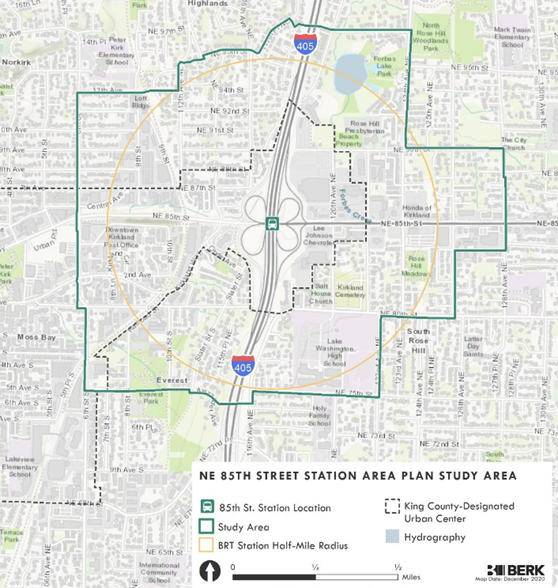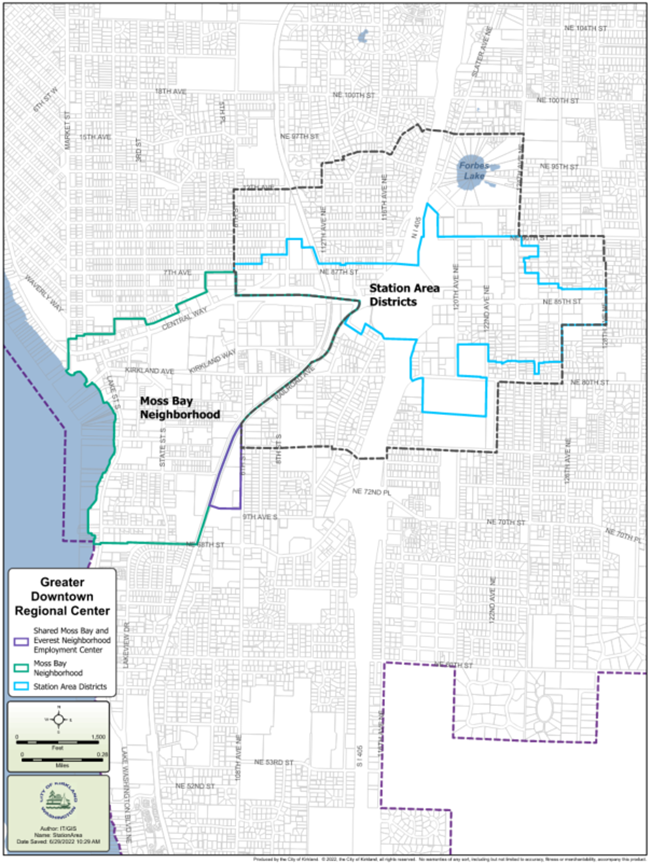2. OVERVIEW AND PLANNING CONTEXT OF SUBAREA PLAN
This NE 85th Street Station Area Subarea Plan establishes the vision, goals, and policies for how the area within an approximately 1/2-mile radius of the Sound Transit Bus Rapid Transit (BRT) Stride Station and new I-405 interchange at NE 85th Street will evolve into a vibrant, mixed-use environment and a model of innovation with plentiful affordable housing and a mix of high tech and family wage jobs linked by transit.
The Station Area and Rose Hill have always been a local and regional crossroads. The new WSDOT/Sound Transit BRT Station at I-405 and NE 85th will connect Kirkland regionally via the Stride BRT line to Bellevue, Lynnwood, SeaTac, and light rail service, with frequent bus service every 10 to 15 minutes. NE 85th Street provides the main east-west corridor from Downtown Kirkland to Redmond.
The NE 85th Street Station Area Plan, adopted in 2022 (Resolution R-5547), formed the foundation for this Subarea Plan and is a companion document that should be referred to for a summary of the desired community benefits and implementation strategies related to providing affordable housing, mobility, parks and open spaces, sustainability, schools, public infrastructure, and a high level of urban design within the Subarea. The NE 85th Street Station Area Plan also contains the technical reports and studies that were used to inform this Subarea Plan. Background on the NE 85th Street Station Area Plan planning process is described below.
This Subarea Plan provides the policy guidance to help transform a historically auto-oriented commercial corridor into people-centered, placemaking districts with increased community benefits and amenities. This Subarea Plan will be used by decision makers to implement new land use and zoning districts, form-based code zoning regulations and other code amendments, strategies to increase affordable housing, new design guidelines, new street standards, capital improvement infrastructure including transportation mobility, park and open space enhancements, and other public services that are described in more detail by topical area section.
Subarea Overlay Boundaries
The NE 85th Street Station Area Subarea is approximately 710 acres in size and overlays portions of the six neighborhoods (Everest, Highlands, Moss Bay, Norkirk, North Rose Hill, and South Rose Hill) but does not alter any existing neighborhood boundaries. Figure 1 depicts the boundaries for the Subarea Plan. In cases where the Station Area planning process, including its associated environmental review, has established different development standards, the goals, policies, and direction on development standards for the Subarea Plan shall govern. This includes but is not limited to specific land uses, building heights, transportation improvements, and access requirements.

Figure 1: Station Area Planning Boundaries
Greater Downtown Kirkland Regional Center Boundaries
In November 2019, King County Council recognized Greater Downtown Kirkland as an Urban Center, inclusive of core areas surrounding the BRT Station. In addition, the City has applied for formal designation as a Regional Growth Center by the Puget Sound Regional Council. The Regional Center would be defined by the boundaries of the Moss Bay Neighborhood and the core area of the NE 85th Street Station Area Subarea Plan (see Figure 2 for proposed Regional Center boundaries).
Centers plans must conform to the requirements of the Puget Sound Regional Council. These centers form the backbone of the transportation network, linking communities to reduce the rate of growth in vehicle miles traveled and greenhouse gas emissions by focusing land use intensity around the region’s best transportation options. 
Figure 2: Proposed Regional Center Boundaries
Together, the Totem Lake Urban Center (designated in 2003) and Greater Downtown Regional Center plans accommodate the majority of the City’s employment and housing growth to foster increased affordable housing choices, employment, shopping, and other activities in proximity to transit. This centers strategy enables the City to provide long term growth capacity that will continue to meet the City’s growth targets, continue to maintain the lower densities and intensities of the City’s residential neighborhoods, and to focus growth in areas that have the best access to transportation choices, shops, and services. As a focal point for investment and development in the community, the Greater Downtown Regional Center also provides enhanced opportunities to promote equitable access to housing, services, healthcare, education, quality transit service, and employment.
Kirkland has also signed the Growing Transit Communities Compact, providing a commitment to work in partnership with other communities in the Central Puget Sound region to address the objectives of this effort through including strategies in our Comprehensive Plan.
Station Area Plan Background and Planning Process
This Subarea Plan evolved from an extensive community wide planning effort conducted in 2019-2022 to develop the NE 85th Street Station Area Plan. The intent of the Station Area Plan analysis was to explore how the City could fully leverage the significant, voter-approved, regional investment in transit with a land use plan that would result in a walkable, equitable, sustainable, and a complete transit-oriented neighborhood that will provide affordable housing, school capacity, park amenities, family wage jobs, and commercial and retail services.
The Station Area Plan document (adopted by Resolution R-5547) summarizes the entire planning effort including: the community engagement process; various studies that were conducted evaluating demographics, existing conditions, opportunities and challenges of current and potential land use; a market analysis of the Centers’ development potential; the transportation system; public infrastructure necessary to support estimated growth targets; parks, open space and environmental conditions; fiscal impacts and community benefits analysis; equity analysis; urban design studies; the supplemental environmental impact analysis; and form based code regulatory options and development incentives. City Council affirmed the preferred policy direction for the SAP by approving R-5503. As part of the planning process, the Station Area Plan evaluated the potential physical, economic, and cultural displacement of residents and businesses in the Subarea particularly for Black, Indigenous, Immigrant, and other communities at greatest risk. The goals, policies, and implementation frameworks use a range of strategies to mitigate identified displacement impacts.
The Station Area Plan goals and policies build on the existing 2035 Comprehensive Plan; the Highlands, Everest, Norkirk, Moss Bay, and Rose Hill Neighborhood Plans; and the Sustainability Master Plan, Parks, Recreation and Open Space Plan (PROS) Plan, and Active Transportation Plan. It includes development of form-based zoning for the Subarea and a Planned Action – supported by House Bill (HB) 1923 that encouraged cities to streamline creation of housing across the State. The planning process for the Station Area Plan included the issuance of a Supplemental Environmental Impact Statement (SEIS) to the 2035 Comprehensive Plan EIS.

Figure 3: Station Area boundaries and location of Sound Transit BRT Stride Station and WSDOT Interchange project
Station Area Demographics
The Station Area Subarea contains just over 3,000 residents as well as approximately 3,000 jobs. People of all stages of life live, work, learn in, and visit the Subarea. About 22 percent of residents are immigrants. Age distribution tracks with King County population characteristics and the Subarea includes 26 percent youth and 32 percent seniors. There are about 1,600 students at Lake Washington High School and about 490 students at the nearby Rose Hill Elementary School. Between six to eight percent of people in the area overall have disabilities, including difficulties with mobility, vision, hearing, and others.
Compared to other parts of Kirkland, there is a higher proportion of people who rent within the area, rather than owning their homes. Renters include people of all ages and life stages, from students to seniors. About six percent of households in the area are below the poverty line, including clients of Kirkland’s new adult women and family shelter. Many people are burdened by high housing costs, spending a significant share of their income on housing, or may not have secure housing. The share of employees in this area who earn low wages is about 48 percent, compared to about 30 percent of residents in Kirkland, and they may be working multiple jobs to make ends meet.
Additional demographic information gathered for the Station Area and utilized in the Equity Impact Review for the planning effort can be found in the published NE 85th Street Station Area Plan. The Equity Impact Review led the City to ensure that the process was inclusive by engaging members of the community who have typically not been involved in City planning processes. Among the expanded engagement strategies were translation of project materials; focused outreach to renters, local non-profits and their constituents; youth engagement activities; and project engagement materials enabling participation outside of conventional public meetings. The Equity Impact Review also led to a plan that helps ensure equitable and inclusive outcomes through public investment, land use policies, and development regulations that lay the groundwork for a transit-oriented community that promotes equitable access to housing, employment, and transportation opportunities.


